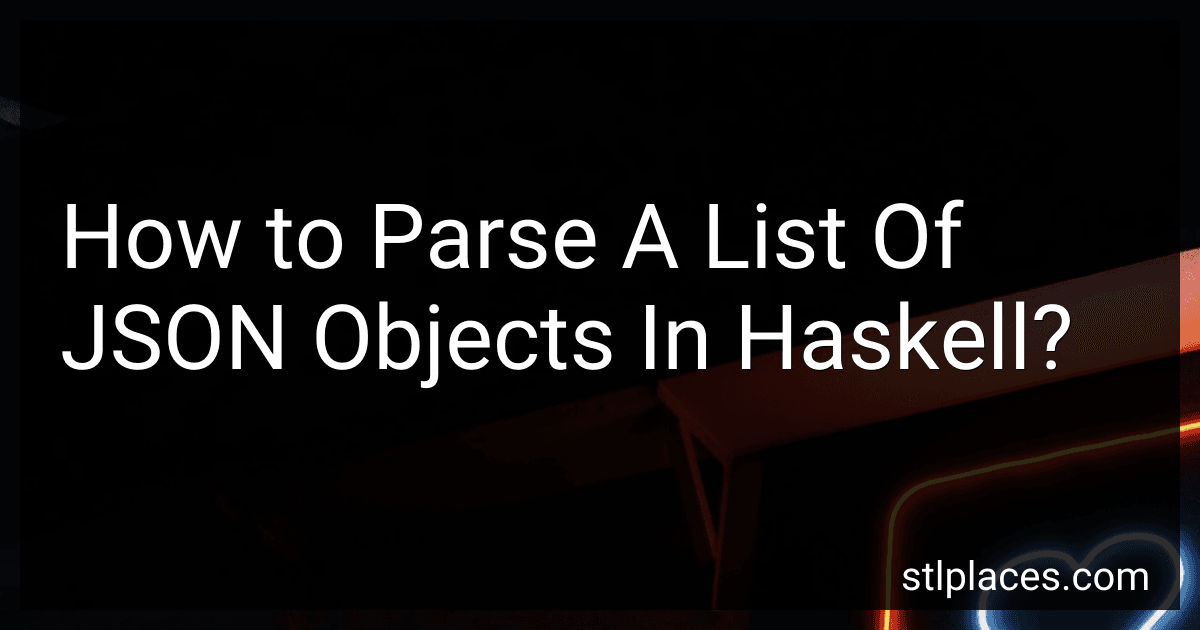Best JSON Parsing Tools in Haskell to Buy in January 2026
In Haskell, parsing a list of JSON objects involves using the Aeson library, which provides functions to convert JSON data into Haskell data types. Here's how you can parse a list of JSON objects step by step:
- First, you need to include the Aeson library in your Haskell project. You can add it as a dependency in your project's Cabal or Stack configuration file.
- Import the necessary modules in your Haskell source file:
import Data.Aeson import qualified Data.ByteString.Lazy as B
- Define a data type that represents the structure of your JSON objects. For example, let's say you have JSON objects with two fields: "name" and "age".
data Person = Person { name :: String , age :: Int } deriving (Show)
- Implement the FromJSON instance for your data type. This will define how to convert the JSON representation into the Haskell representation.
instance FromJSON Person where parseJSON (Object v) = Person <$> v .: "name" <*> v .: "age" parseJSON _ = fail "Invalid JSON object"
- Read the JSON data from a file or any other source as a lazy ByteString.
jsonData <- B.readFile "data.json"
- Convert the JSON data into a list of Person objects using the decode function from Aeson.
let maybePersons = decode jsonData :: Maybe [Person]
- Check for any a parsing errors or retrieve the list of Person objects if the parsing was successful.
case maybePersons of Just persons -> do -- Work with the list of Person objects print persons Nothing -> putStrLn "Failed to parse JSON"
With these steps, you will be able to parse a list of JSON objects into a list of Person objects by leveraging the Aeson library in Haskell. Remember to handle potential errors that may occur during the parsing process.
What is a JSON object?
A JSON (JavaScript Object Notation) object is a structured data format commonly used for transferring and storing data. It consists of key-value pairs where keys are strings enclosed in double quotes, followed by a colon, and then a value. The value can be a number, string, boolean, array, another JSON object, or null. JSON objects are often used to exchange data between a server and a web application as they provide an easy-to-read and flexible format that can be easily parsed and transformed into JavaScript objects.
How to parse a single JSON object in Haskell?
To parse a single JSON object in Haskell, you can use libraries like aeson or json. Here's an example using the aeson library:
- First, make sure you have the aeson library installed. You can add it to your project by adding it to your cabal or stack file.
- Import the required modules:
import Data.Aeson import Data.ByteString.Lazy (ByteString) import qualified Data.ByteString.Lazy.Char8 as BS
- Define a Haskell data type that corresponds to the structure of your JSON object. For example, let's say you have the following JSON object:
{ "name": "John", "age": 30, "city": "New York" }
You can define a corresponding Haskell data type as follows:
data Person = Person { name :: String , age :: Int , city :: String } deriving (Show)
- Write a parser function that converts the JSON object to your Haskell data type:
parseJSONObj :: ByteString -> Maybe Person parseJSONObj json = decode json :: Maybe Person
Note: The decode function is provided by the aeson library to parse JSON values into Haskell values.
- Test the parser function using a sample JSON object:
main :: IO () main = do let jsonStr = "{\"name\":\"John\",\"age\":30,\"city\":\"New York\"}" let maybePerson = parseJSONObj $ BS.pack jsonStr case maybePerson of Just person -> print person Nothing -> putStrLn "Failed to parse JSON object"
This will output: Person {name = "John", age = 30, city = "New York"}.
Note that the Maybe type is used here because the parsing operation may fail. In case of success, you will get a Just value containing the parsed object. Otherwise, you'll get a Nothing value indicating a failure.
What is the importance of JSON parsing in web development using Haskell?
JSON parsing is important in web development using Haskell for several reasons:
- Communication: JSON is a common format for exchanging data between a client and a server. When a web application sends or receives data in JSON format, it needs to parse that JSON data to be able to work with it. Haskell provides powerful JSON parsing libraries that make it easy to handle JSON data.
- Data Processing: Many web applications deal with large amounts of data, and JSON is often used as a convenient format for storing and transmitting that data. By parsing JSON, Haskell allows developers to extract specific information from the JSON data, manipulate it, and perform various operations on the data.
- Integration: JSON parsing is crucial for integrating web applications with other services and APIs. Many APIs return data in JSON format, and to interact with those APIs, developers need to parse the JSON responses. Similarly, when a web application serves data to other services or clients, it often needs to convert internal Haskell data structures to JSON format.
- Validation: JSON parsing involves verifying that the incoming data adheres to a specific format or schema. Haskell's JSON parsing libraries allow developers to define and enforce data validation rules, ensuring that the JSON data meets the expected structure and values. This helps in maintaining data integrity and preventing errors.
- Web Application Development: In web development, front-end frameworks like React or Angular often communicate with back-end APIs built in Haskell. The communication between the front-end and back-end typically happens in JSON format. Thus, JSON parsing is essential for processing the data received from the front-end and converting it into Haskell data structures for further processing or storage.
In summary, JSON parsing plays a vital role in web development using Haskell, enabling communication, data processing, integration with other services, validation, and seamless interaction between front-end and back-end components.
How to handle optional fields in JSON parsing in Haskell?
When handling optional fields in JSON parsing in Haskell, you can use a combination of the .:? operator from the Data.Aeson library and Maybe data type. Here's an example of how to handle optional fields in JSON parsing:
Let's say we have a JSON object with optional fields:
{ "name": "John Doe", "age": 30, "email": "john.doe@example.com" }
First, define a Haskell data type to represent the JSON object:
import Data.Aeson
data Person = Person { name :: String , age :: Int , email :: Maybe String } deriving (Show)
Then, implement the FromJSON instance for the Person type:
instance FromJSON Person where parseJSON (Object v) = Person <$> v .: "name" <*> v .: "age" <*> v .:? "email" parseJSON _ = fail "Expected an object for Person"
In this example, .: is used to parse required fields (name and age), and .:? is used to parse the optional field (email). The .:? operator returns a Maybe type, which will be Nothing if the field is missing from the JSON object, or Just value if the field is present.
Now, you can parse the JSON object into the Person type:
import Data.Aeson import Data.ByteString.Lazy as B
main :: IO () main = do input <- B.readFile "example.json" case decode input of Just person -> print (person :: Person) Nothing -> putStrLn "Failed to parse JSON"
In the main function, decode function from Data.Aeson is used to parse the JSON input into a value of type Maybe Person. If the decoding is successful, it will print the resulting Person record. Otherwise, it will show an error message.
What is the role of FromJSON and ToJSON typeclasses in JSON parsing in Haskell?
The FromJSON and ToJSON typeclasses in Haskell are used for parsing and encoding JSON data respectively. These typeclasses are part of the aeson library, which is commonly used for working with JSON in Haskell.
The role of the FromJSON typeclass is to define how to parse JSON data into Haskell types. It provides a function called parseJSON, which takes a Value (the JSON representation) and returns a Parser monad that produces the desired Haskell type. Instances of the FromJSON typeclass define the implementation of parseJSON for a specific type, allowing the aeson library to automatically decode JSON data into Haskell values.
The ToJSON typeclass, on the other hand, is used for encoding Haskell types into JSON. It provides a function called toJSON, which takes a Haskell value and returns a Value representing the JSON representation of that value. Instances of the ToJSON typeclass define how to convert a specific type into Value, allowing the aeson library to automatically encode Haskell values into JSON.
By defining instances of FromJSON and ToJSON for custom types, one can leverage the aeson library's powerful parsing and encoding capabilities to easily work with JSON data in Haskell. The fromJSON and toJSON functions provided by the aeson library can then be used to perform JSON parsing and encoding operations respectively.
What is the role of JSON decoding options in Haskell?
JSON decoding options in Haskell are used to specify how to interpret and handle the decoding of JSON data. These options provide fine-grained control over various aspects of the decoding process, such as how to handle missing fields, how to decode different data types, and how to represent data in the decoded output.
Some common JSON decoding options in Haskell include:
- Field omission handling: Options to handle missing fields in JSON objects. These options can specify whether missing fields should be treated as an error, ignored, or given a default value.
- Data type conversion: Options to control how JSON values should be decoded into Haskell data types. For example, these options can specify how to interpret JSON booleans, numbers, and strings, and how to represent them in the corresponding Haskell types.
- Sum types handling: Options to handle JSON encoding/decoding for sum types (also known as tagged unions or disjoint unions). These options can specify how to represent sum types in JSON, either as a tagged object or as a discriminated union using a special "tag" field.
- Custom decoding functions: Options to provide custom decoding functions for complex types that do not have a straightforward mapping to JSON. This allows users to write their own decoding logic for such types.
- Error handling: Options to control how to handle decoding errors. These options can specify whether decoding errors should be treated as exceptions, as part of the decoded output, or logged in a specific way.
Overall, JSON decoding options in Haskell provide flexibility in handling different JSON structures, data types, and error conditions, allowing for more precise and customizable decoding behaviors.



